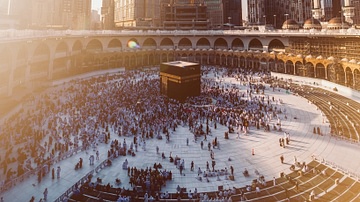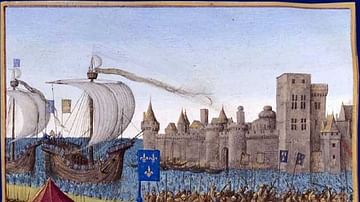Search
Did you mean: Deir el-Medina?
Search Results

Article
First Battle of El Alamein
The First Battle of El Alamein (1-27 July 1942) was a series of encounters during the Second World War (1939-1945) in Egypt between Allied and Axis forces. The battle, focussed around the El Alamein defensive line, ended without a decisive...

Article
Wonderful Things: Howard Carter's Discovery of Tutankhamun's Tomb
The great discoverer of the treasures of King Tutankhamun, Howard Carter, was born on May 9, 1874 CE to Samuel John and Martha Joyce (Sands) Carter in Kensington, England. A sick, home-schooled child, Carter learned to draw and paint from...

Image
A View of the Al-Masjid An-Nabwi
A photo of Al-Masjid An-Nabawi in Medina, Arabia. It shows a view of the mosque from the south, with the minaret of Bab al-Baqi and the Green Dome to the right (foreground) and the minaret of Bab as-Salam to the left (foreground). The mosque...

Image
Al-Masjid an-Nabawi
Aview of the Al-Masjid An-Nabawi in Medina, Arabia. The mosque was built by the Islamic prophet Muhammad c. 622 CE, and over the centuries has been expanded and renovated significantly by later rulers.

Image
View of the Ka'ba
A view of the Ka'ba in Medina.

Definition
Ottoman Empire
The Ottoman Sultanate (1299-1922 as an empire; 1922-1924 as caliphate only), also referred to as the Ottoman Empire, written in Turkish as Osmanlı Devleti, was a Turkic imperial state that was conceived by and named after Osman (l. 1258-1326...

Definition
Jerusalem
Jerusalem is a major holy city for the three Western traditions of Judaism, Christianity, and Islam. It sits on spurs of bedrock between the Mediterranean Sea and the Dead Sea area. To the north and west, it tapers off to the Jezreel Valley...

Definition
Abbasid Dynasty
The Abbasids were an Arabic dynasty that initially ruled over most of the Islamic empire (save some western parts) after assuming the caliphate in 750 CE, later on, their empire fragmented, however, they retained spiritual supremacy as caliphs...

Definition
Suleiman the Magnificent
Suleiman the Magnificent (aka Süleyman I or Suleiman I, r. 1520-1566) was the tenth and longest-reigning sultan of the Ottoman Empire. Hailed as a skilled military commander, a just ruler, and a divinely anointed monarch during his lifetime...

Definition
Eighth Crusade
The Eighth Crusade of 1270 CE was, like the Seventh Crusade (1248-1254 CE), led by the French king Louis IX (r. 1226-1270 CE). As previously, the idea was to attack and defeat the Muslims first in Egypt and then either reconquer or negotiate...